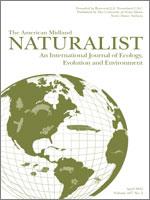Free-ranging, juvenile thirteen-lined ground squirrels (Ictidomys tridecemlineatus) in southwestern Michigan were fitted in late summer or fall with external skin-temperature loggers. Data were obtained the following spring for five males and three females. During the heterothermal period, all squirrels exhibited 11–22 prolonged ( = 9.4 d) torpor bouts punctuated by typically brief (
= 9.4 d) torpor bouts punctuated by typically brief ( = 14.3 h) arousal bouts, with mean monthly torpor bouts becoming longer and deeper until Feb. and reversing thereafter. Torpor-bout duration increased as minimum skin and soil temperatures decreased. On average, males initiated the first torpor bout later in fall, terminated the last torpor bout significantly earlier in spring and thus spent less time in the heterothermal period than did females. Three males displayed relatively short torpor bouts and long arousal bouts as they approached the end of hibernation. Squirrels gained weight variably in fall and spring, and one female lost 39% of body mass during hibernation.
= 14.3 h) arousal bouts, with mean monthly torpor bouts becoming longer and deeper until Feb. and reversing thereafter. Torpor-bout duration increased as minimum skin and soil temperatures decreased. On average, males initiated the first torpor bout later in fall, terminated the last torpor bout significantly earlier in spring and thus spent less time in the heterothermal period than did females. Three males displayed relatively short torpor bouts and long arousal bouts as they approached the end of hibernation. Squirrels gained weight variably in fall and spring, and one female lost 39% of body mass during hibernation.
How to translate text using browser tools
1 April 2012
Hibernation and Overwinter Body Temperatures in Free-Ranging Thirteen-Lined Ground Squirrels, Ictidomys tridecemlineatus
Brooke Kisser,
H. Thomas Goodwin
ACCESS THE FULL ARTICLE
It is not available for individual sale.
This article is only available to subscribers.
It is not available for individual sale.
It is not available for individual sale.

The American Midland Naturalist
Vol. 167 • No. 2
April 2012
Vol. 167 • No. 2
April 2012




